Posterior Tibial Tendon Problems
A Patient’s Guide to Posterior Tibial Tendon Problems
Introduction
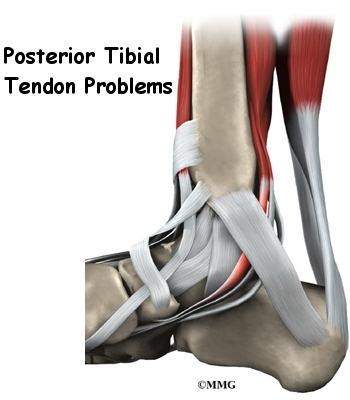
Because we use our feet continuously, tendonitis in the foot is a common problem. One of the most frequently affected tendons is the posterior tibial tendon.
This guide will help you understand
- how posterior tendonitis develops
- how the condition causes problems
- what can be done to treat it
Anatomy
The posterior tibial tendon runs behind the inside bump on the ankle (the medial malleolus), across the instep, and into the bottom of the foot. The tendon is important in supporting the arch of the foot and helps turn the foot inward during walking.
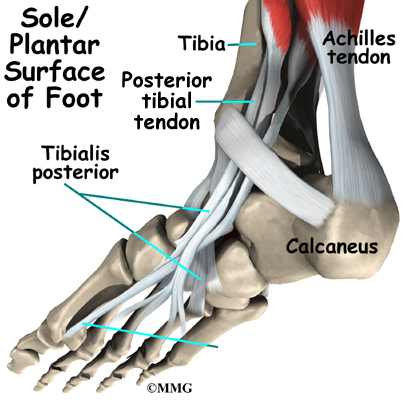
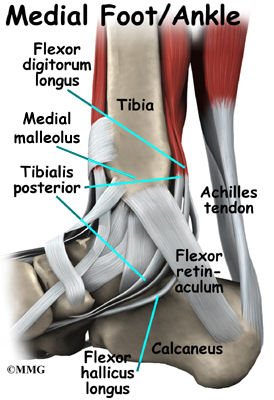
Causes
How does tendonitis of the foot develop?

Problems with the posterior tibial tendon seem to occur in stages. Initially, irritation of the outer covering of the tendon, called the paratenon, causes paratendonitis. This means the tendon is inflamed where it runs through the tunnel behind the medial malleolus.
As we age, our tendons can degenerate, or wear down and weaken over time. Degeneration in a tendon usually shows up as a loss of the normal arrangement of the fibers of the tendon.
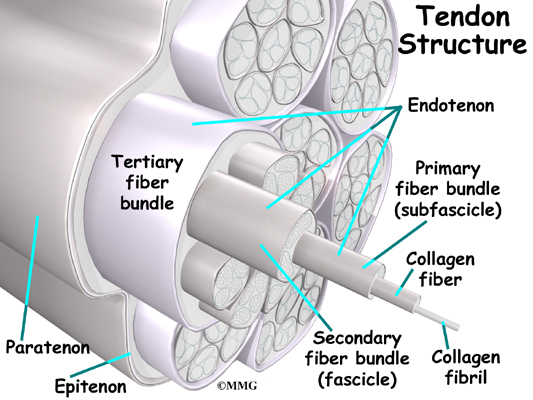
Tendons are made up of strands of a material called collagen. Think of a tendon as similar to a nylon rope and the strands of collagen as the nylon strands. Some of the individual strands of the tendon become jumbled because of degeneration, other fibers break, and the tendon loses strength.
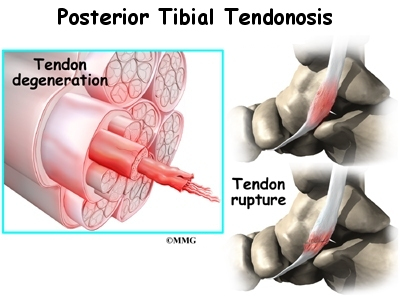
As the tendon heals itself from wear and tear, scar tissue forms, thickening the tendon. This process can continue to the extent that a nodule, or knot, forms within the tendon. This condition is called tendonosis. The area of tendonosis in the tendon is weaker than normal tendon. The weakened tendon sets the stage for the possibility of rupture of the tendon. Tendonosis may develop into tendonitis if the weakened area becomes inflamed.
Symptoms
What does tendonitis of the foot feel like?
The symptoms of tendonitis of the posterior tibial tendon include pain in the instep area of the foot and swelling along the course of the tendon. In some cases the tendon may rupture, due to weakening of the tendon by the inflammatory process. Rupture of the tendon leads to a fairly pronounced flatfoot deformity that is easily recognizable.
Diagnosis
How do doctors identify tendonitis?
Diagnosis of posterior tibial tendonitis is usually apparent on physical examination. In some difficult cases, a magnetic resonance imaging (MRI) scan may be necessary to confirm whether the tendon has ruptured. This is seldom the case. The MRI machine uses magnetic waves rather than X-rays to show the soft tissues of the body. The MRI creates images that look like slices and shows the tendons and ligaments very clearly. This test does not require any needles or special dye and is painless.
Treatment
What can be done for the condition?
Nonsurgical Treatment
Treatment of posterior tibial tendonitis begins with the use of a firm arch support inserted into you shoe. The arch support is useful because it supports the arch and takes some of the stress off the tendon. To rest the tendon, you may need to decrease the time you spend up on your feet. Additionally, your doctor may prescribe anti-inflammatory medications, such as ibuprofen or aspirin.
A cortisone injection, sometimes used to ease inflammation in other types of injuries, is usually not appropriate for this condition, since the tendon is more likely to rupture following injection. Some physicians recommend a slightly different cortisone treatment (rather than injection) called iontophoresis. Iontophoresis is a treatment that uses electric current to deliver cortisone medicine through the skin to the inflamed tendon. The risk of tendon rupture is much less when this method is used.
Surgery
If all else fails to resolve your condition, surgery may be required.
Tendon Debridement
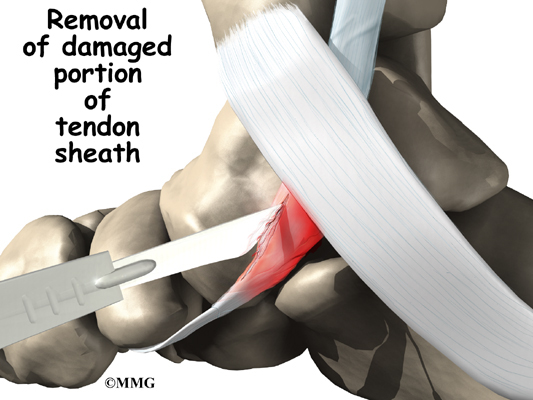
If the problem appears to be primarily tendonitis with thickening of the tissue around the tendon (the tendon sheath), a tendon debridement operation can be performed to remove the thickened tissue around the tendon. This is done to try to decrease the symptoms of pain and to prevent rupture of the tendon.
This procedure is usually done through a small incision in the instep of the foot just over the posterior tibial tendon. The surgeon simply identifies the tendon and removes the thickened tissue.
Tendon Repair
A degenerated tendon that has not ruptured may only need to be repaired. The surgeon divides the sheath around the tendon. Areas where the tendon is degenerated are carefully removed. Tears within the tendon are sutured along the length of the tendon. If the surgeon is concerned that the repaired tendon is at risk for rupturing, a graft procedure to add strength to the tendon may be needed (described below). The tendon sheath is repaired, and the skin is closed with sutures.
Tendon Graft
A badly degenerated or a ruptured tendon may require a tendon graft. Usually, another tendon in the foot, such as the tendon that flexes the four smaller toes (the flexor digitorum longus), is used as a tendon graft to work in place of the posterior tibial tendon.
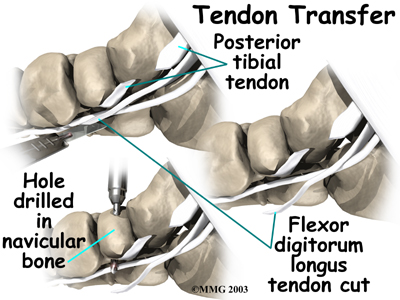
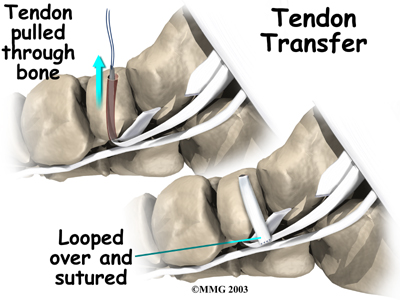
Fusion
Finally, in cases which have been neglected and a fixed flatfoot deformity is present, a fusion (or arthrodesis) of the foot may be required. A fusion is an operation where a joint between two bones is removed and the two bones on either side of the joint are allowed to grow together, or fuse. This type of operation is used to stop pain from joints that are worn out. It can be used to realign the bones when the mechanisms for maintaining normal alignment are lost, such as when the tendons and ligaments no longer work properly. Usually, several joints must be fused to control a flatfoot deformity that develops after a posterior tibial tendon rupture.
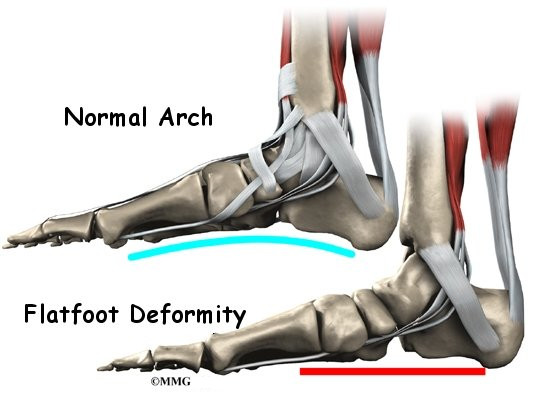
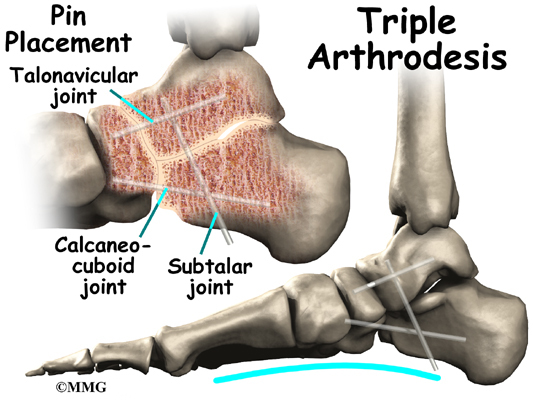
Rehabilitation
What should I expect following treatment?
Nonsurgical Rehabilitation
Patients with posterior tibialis tendon problems may benefit with physical therapy treatments. Treatments directed to the painful area help control pain and swelling. Examples include ultrasound, moist heat, and soft-tissue massage. Therapists design stretches to improve flexibility in the calf muscles and to encourage healing in the posterior tibialis tendon.
Exercises to strengthen the posterior tibialis muscle and the small muscles within the feet (the intrinsics) help support the arch.
Therapists also design orthotics to support the arches of the feet. Wearing orthotics in your shoes may be allow you to resume normal walking immediately, but you should probably cut back on more vigorous activities for several weeks to allow the inflammation and pain to subside.https://9782418e05f6194dd1101eeca5149c59.safeframe.googlesyndication.com/safeframe/1-0-38/html/container.html
After Surgery
It will take about eight weeks before the soft tissues are well healed after surgery. If the tendon has been repaired or grafted, you will be placed in a cast or cast boot during this period to protect the tendon while it heals. You will probably need crutches as well. A physical therapist may be consulted to help you learn to use your crutches.
You will likely wear a bandage or dressing for about a week following the procedure. The stitches will be removed in 10 to 14 days. If your surgeon used dissolvable stitches, these will not need to be removed.
Physical therapy may be needed after a repair or graft procedure for up to four months. Ice, massage, and whirlpool treatments may be used at first to control swelling and pain. Massage and ultrasound help heal and strengthen the tendon.
Treatments progress to include more advanced mobility and strengthening exercises, some of which may be done in a pool. The buoyancy of the water enables people to walk and exercise safely without putting too much tension on the healing tendon.
As your symptoms ease and your strength improves, you will be guided through advancing stages of exercise. Athletes begin running, cutting, and jumping drills by the fourth month after surgery. They are usually able to get back to their sport by six full months after surgery.
The physical therapist’s goal is to help you keep your pain and swelling under control, improve your range of motion and strength, and ensure you regain a normal walking pattern. When you are well under way, regular visits to the therapist’s office will end. Your therapist will continue to be a resource, but you will be in charge of doing your exercises as part of an ongoing home program.